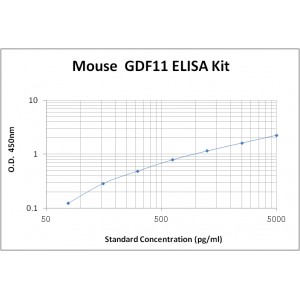More info
Assay Range | 78.12--5000 pg/mL |
Sensitivity | 5.0 pg/mL |
Specificity | No cross-reaction with other related substances detected |
Size | 96T |
Storage | Store at 2 - 8ºC. Keep reconstituted standard and detection Ab at -20 ºC |
Assay Principle | Sandwich ELISA |
Sample Volume | 100 µL final volume, dilution factor varies on samples |
Sample Type | serum, plasma, body fluids, tissue lysate or cell culture supernatant |
Detection Method | Chromogenic |
Kit Components
1. Mouse GDF11 standard: 5.0 ng/vial -2 |
2 96-well plate pre-coated with Mouse GDF11 Ab: 1 |
3. Sample Diluent buffer: 12 mL - 1 |
4. Sample activation reagent A 5 ml |
5. Sample activation reagent B 5 ml |
6. Detection antibody: 1 vial, dilution 1:100 |
7. Streptavidin-HRP: 1 vial, dilution 1:100. |
8. Antibody diluent buffer: 12 ml |
9. Streptavidin-HRP diluent buffer: 12 ml |
10. TMB developing agent: 10 ml |
11. Stop Solution: 10 ml |
Background
GDF11 (Growth differentiation factor 11), also known as bone morphogenetic protein 11 (BMP-11), is a member of transforming growth factor beta superfamily (TGFβ). The mature 109 amino acid (aa) GDF11, derived from the full-length 407 aa GDF11 precursor protein, contains a canonical 7cysteine motif of the TGFβ superfamily members. GDF11 plays a key role in regulating embryonic development. This cytokine inhibits the proliferation of olfactory receptor neuron progenitors to regulate the number of olfactory receptor neurons occurring in the olfactory epithelium, and controls the competence of progenitor cells to regulate numbers of retinal ganglionic cells developing in the retina. Other studies in mice suggest that GDF11 is involved in mesodermal formation and neurogenesis during embryonic development. GDF11 knock-out mice show diverse abnormalities including palatal malformation, vertebral defects, elongated trunks with a reduced or absent tail, missing or malformed kidneys, and an increased number of neurons in the olfactory epithelium.
GDF11 has been identified as a blood circulating factor that has the ability to reverse cardiac hypertrophy in mice as a result of hypertrophy related to aging. GDF11 gene expression and protein abundance decreases with age, and it shows differential abundance between young and old mice in parabiosis procedures, causing youthful regeneration of cardiomyocytes, a reduction in the Brain natriuretic peptide (BNP) and in theAtrial natriuretic peptide (ANP).GDF11 also causes an increase in expression of SERCA-2, an enzyme necessary for relaxation during diastolic functions. GDF11 activates the TGF-β pathway in cardiomyocytes derived from pluripotent hematopoietic stem cells and suppresses the phosphorylation of Forkhead (FOX proteins) transcription factors.


